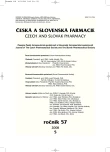Effect of montelukast on the treatment of asthma bronchiale in pediatric patients with perennial allergic rhinitis
Authors:
L. Bartošíková 1; J. Nečas 1; T. Bartošík 2; M. Pavlík 2; P. Fráňa 3; L. Fráňa 4
Authors‘ workplace:
Univerzita Palackého Olomouc, Lékařská fakulta, Ústav fyziologie
1; Fakultní nemocnice U sv. Anny v Brně, Anesteziologicko-resuscitační klinika
2; Fakultní nemocnice U sv. Anny v Brně, II. Interní klinika
3; Alergologická a imunologická ambulance, Velké Meziříčí
4
Published in:
Čes. slov. Farm., 2008; 57, 221-224
Category:
Original Articles
Overview
Antileukotrienes represent a group of medicaments used in the treatment of bronchial asthma and allergic rhinitis. Montelukast is a drug belonging to the group of medicaments blocking leukotriene receptors (Cys-LT 1 receptor). It is a specific leukotriene receptor antagonist with strong anti‑inflammatory effects designed for oral administration. The study monitors the effectiveness and safety of the treatment with montelukast, administered once a day in the evening in 5mg dose, over a 4-month period, to a group of children with the diagnosis of mild persistent bronchial asthma with deterioration of problems after exercise and with perennial allergic rhinitis. The results of the study demonstrate significant positive effects of the preparation used. A significant improvement of FEV1 and PEF values was registered, as well as a statistically significant remission of both day and nocturnal symptoms of the disease and significantly lower consumption of short-acting β₂‑sympathomimetics. No adverse effects were observed.
Key words:
antileukotrienes – montelukast – bronchial asthma – allergic rhinitis
Sources
1. Turzíková, J., Fuchs, M., Špičák, V.: Alergie, 2000; 2, 18–21.
2. Bartošíková, L., Fráňa, L., Nečas, J., Fráňa, P.: Klin. Imunol. Alergol, 2000; 3, 24–30.
3. Weiss, T. F., Chervinskyi, P., Dockhorn, R. J. et al.: Arch. Intern. Med. 1998; 158, 1213–1220.
4. Leff, J. A., Busse, W. W., Pearlman, D. et al.: N. Engl. J. Med., 1998; 339, 147–152.
5. Busse, W. W., Casale, T. B., Dykewicz, M. S. et al.: Ann. Allergy Astma Immunol., 2006; 96, 60–68.
6. Shirasaki, H.: Exp. Opin. Ther. Targets, 2008; 12, 415–423.
7. Global strategy for astma management and prevention. Global initiative for astma. NHL-BI/WHO. NIH Publication No. 02-3659, 2002.
8. Globální strategie péče o astma a jeho prevenci. Eds. Špičák, V., Kašák, V., Pohunek, P. Jalna ČIPA: 2003; 200.
9. GINA Workshop Report – updated November 2003, .
10. Pocket Guide for Astma Management and Prevention – updated November 2003, .
11. Kašák, V., Pohunek, P.: Remedia, 2004; 14, 419–423.
12. Coults, J. A. P., Gibbon, N. A., Paton, J. Y.: Arch. Dis. Child., 1992; 67, 332–333.
13. Chapman, K. R., Walker, L., Clulely, S., Fabri, L.: Respir. Med., 2000; 94, 2–9.
14. Barnes, P. J.: Respir. Med., 2002; 96 (Suppl. A), S9–S15.
15. Nayak, A., Langdon, R. B.: Drugs, 2007; 67, 887–901.
16. Santos, C. B., Hanks, C., McCann, J. et al.: Allergy Astma. Proc., 2008; 29, 140–145.
17. Nayak, A.: Exp.Opin. Pharmacother., 2004; 5, 679–686.
Labels
Pharmacy Clinical pharmacologyArticle was published in
Czech and Slovak Pharmacy

2008 Issue 5
Most read in this issue
- History and the present state of hypolipidaemic therapy
- Effect of montelukast on the treatment of asthma bronchiale in pediatric patients with perennial allergic rhinitis
- Medicinal preparations in Prague pharmacies at the end of the 16th century
- Impact of demographic factors on consumption of pharmaceuticals in the Czech Republic
